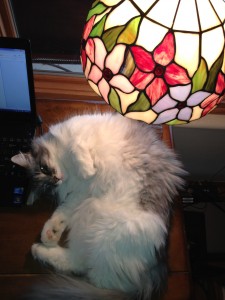Now that the weather is turning cool, I’m getting more frequent cuddly desk companions again. I’m sure it’s me they love, not my warm lamp.
I used to have this writing teacher who did not believe in revising via word processor. Yes – she was old school. But she was firmly convinced that the advent of word-processing software had created lazy revisers, because writers could cut, paste, rearrange and massage the existing words. Before the software, revising meant retyping or rewriting by hand from beginning to end. She thought that recasting the story from the beginning led to greater insights and a more cohesive product. She exhorted us to resist the urge to revise the existing document and instead, type it again from the beginning, the old-fashioned way.
Of course, we all rolled our eyes at her and totally ignored this advice. I mean, who has the freaking time? When you have this great technology that lets you tweak an existing document, why on earth would anyone spend all that time and effort to type it all out again?? So none of us followed her advice.
More and more, though, I’m starting to think she’s right.
Not that I do it.
Those of you keeping track at home know that I’m deep into writing the sequel to Rogue’s Pawn, fondly known as RP2, because I haven’t decided what title I want to propose. I’m kind of waiting to see how the story turns out.
(I love to say things like that, just to imagine all the plotters clutching their heads with anxiety.)
A couple of days ago I realized I’d forgotten to weave in a thread that I needed and that a scene I’d cut from Rogue’s Pawn was exactly what should go there. For all of you readers who bitched noticed that there were some questions left unanswered in the first book, this is part of why. There were chunks that had to be cut out, just to find some kind of reasonable conclusion. I always knew they’d work into the later stories somehow (or hoped), but I wasn’t sure where or how.
So, on Wednesday I pasted in this 5K chunk and yesterday I set to massaging it into place. A task I thought would go quickly.
Um, no.
In fact, having cut half of it and writing a whole bunch of new stuff, I’m still nowhere done with that section.
Worse, I’m starting to realize that if I’d just rewritten the scene, I’d likely be done already.
It’s difficult to explain why, but it’s somehow more challenging to wrestle old work into a new mold that to just write something fresh in the new vein. A lot has changed in the story. This is a scene between Rogue and Gwynn and their dynamic has come a long way. So the way they talk to each other, touch each other, where they’re at in their heads, their goals and desires – all of these things have changed. And that all requires subtle reworking of what they say, how they say it and when, the tone, pacing, word choice.
Yeah, I’m clutching my own head. I totally deserve that.
So, will I just rewrite the damn scene from the beginning? Probably not. It’s reworked now. I did end up just cutting the rest of the scene and I’ll write the second half of it fresh, because a lot of that part no longer applied.
I did a post about six months back on Letting the Babies Stay Dead. It elicited some lively debate on whether outtakes (those babies that need to be “killed” or cut out) should be kept or ditched entirely. In that I said I wondered if I should give all of mine a decent burial, instead of keeping them around in case I could reanimate them.
Clearly I didn’t do it and now I’m looking at the monster I brought back to life by patching new flesh onto old and I’m thinking that if I hadn’t saved that scene, I would have had to retype it from the beginning. Just like my teacher advised us to do.
One of these days I’ll learn my lesson.

